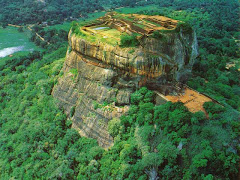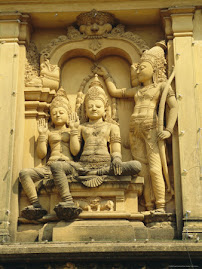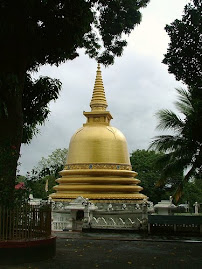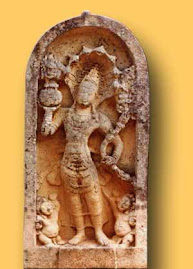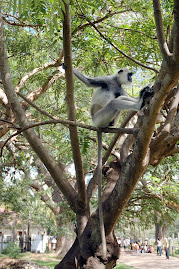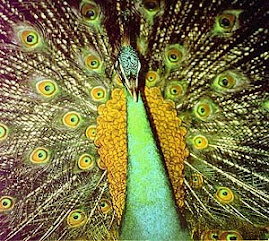
Sri Pada: Buddhism’s Most Sacred Mountain
Sri Pada soars upwards to a height of 7360 feet from the very edge of the central highlands and viewed from the southwest looks like a pinnacle on a verdant castle wall. For about half the year it is often hidden in cloud and the torrential rains that rush down its steep sides during this time makes visiting the summit almost impossible. This abundant precipitation feeds Sri Lanka's four main rivers which all have their sources on the mountain's lower slopes. Over the aeons these rains have also washed nearly a thousand feet of rock and soil off Sri Pada and its surrounding peaks and the alluvial deposits that extend from its foot towards the south and east are one of the world's richest gem mining areas. Here are found rubies, topaz, garnets, cats eye, aquamarine, Alexanderite and sapphires ranging in colour from yellow to blue. Like the mountain itself many legends are told about these gems. The Arabs believed they were the crystallised tears Adam and Eve shed when they were expelled from Paradise. The story the Chinese told about them was even more beautiful. They said that when the Buddha visited Sri Lanka he found the people poor and given to theft. So out of compassion and to turn them to virtue he sprinkled the island with sweet dew which crystallised into gems thus freeing the people from poverty by giving them a commodity to trade with.
Sri Pada is surrounded by exceptionally dense forest, much of it now making up the Peak Wilderness Sanctuary. This is not the lush steamy cover one usually associates with the tropics but a cool misty forest similar to that found in the lower reaches of the Himalayas. Giant trees hang heavy with moss, rhododendrons put forth large red blossoms and rare orchids like the Regal and the Chandraraja grow in the dark moist loam.In the past Sri Pada's forests were the home of numerous elephants and the animal was so identified with the mountain that it came to be seen as the mount of Samanta. In 1840 Major Skinner, the famous engineer, actually reported finding elephant droppings on the very top of Sri Pada early one morning. But with the establishment of the coffee plantations in the 1850's these majestic creatures were completely shot out although pilgrims still occasionally report seeing Samanta's white elephant as they make the nocturnal jour
 ney up the mountain. Of the two animals still associated with Sri Pada the first is the butterfly.Today the jungle besides the paths that lead up the mountain is cut back at the beginning of each the pilgrim season thus lessening this problem.
ney up the mountain. Of the two animals still associated with Sri Pada the first is the butterfly.Today the jungle besides the paths that lead up the mountain is cut back at the beginning of each the pilgrim season thus lessening this problem.However it not Sri Pada's geological particularities or natural beauty that has made it so famous but something else altogether. On the summit of the mountain is a boulder with a mysterious mark or indentation on it resembling a human footprint. Since from perhaps as early as the first century BCE the Sinhalese believed this mark to be the footprint of the Buddha himself. According to the Mahavamsa, the Buddha visited the island three times. During his last sojourn he flew from Kelaniya to Sri Pada, leaving the impression of his foot on the mountain top, and then left for Dighavapi. Whether the Buddha's journey to Sri Lanka is true or not as a metaphor it is very true. The Buddha's teaching has left its impression on every aspect of Sri Lankan life as surely and as indelibly as if it had been engraved in stone. Legend says that after King Valagambha was driven from his throne in 104 BCE, he lived in a remote forest wilderness for 14 years. On one occasion while stalking a deer he was led up the mountain and discovered the sacred footprint. The gods revealed to him that it had been made by the Buddha. The legend of the Buddha's visits to Sri Lanka is not, it should be noted, confined to the Theravada tradition. The Lank
 avatara Sutra, the seminal text of the Ch'an and Zen schools of Buddhism, was supposedly taught by the Buddha while residing on Malayagiri, "which shone like a jewel lotus, immaculate and shining in splendour". The Chrakasamvara Tantra mentions the Buddha flying to Lanka and leaving the impression of his foot on a mountain which it doesn't name but which at least one contemporary Tibetan scholar has mistakenly identified as Mount Kailash in the western Himalayas. While Buddhists knew that this mysterious footprint had been made by the Buddha in succeeding centuries other faiths, Islam, Hinduism and Christianity were to lay claim to it also. A 15th century Chinese work says the footprint was made by Pwan-ko, the primordial man of Chinese mythology. South Indian Hindus believed it had been made by Shiva. Moses of Chorene never saw the footprint himself but proclaimed that it had been made by the Devil. The Portuguese could never quite make up their minds whether it had been made by Adam, St Thomas or the eunuch of Candace, Queen of Sheba, although they never doubted its veracity. Ibn Batuta mentioned that sometime before his visit the Chinese had come and cut the mark of the big toe out of the rock and enshrined in a temple in China "where it is visited by people from the farthest parts of the land". An early Thai king sent monks to Sri Lanka to make an impression of the footprint and then had copies made in bronze and distributed all around his kingdom. (see above: copy of the Buddha's Footprint from Sri Pada, Sukhodaya style, 14th century). The famous statue of the Buddha from Sukhodaya with its beautiful flowing lines, does not depict him walking, as is commonly supposed, but him making the mark of his foot on Sri Pada.
avatara Sutra, the seminal text of the Ch'an and Zen schools of Buddhism, was supposedly taught by the Buddha while residing on Malayagiri, "which shone like a jewel lotus, immaculate and shining in splendour". The Chrakasamvara Tantra mentions the Buddha flying to Lanka and leaving the impression of his foot on a mountain which it doesn't name but which at least one contemporary Tibetan scholar has mistakenly identified as Mount Kailash in the western Himalayas. While Buddhists knew that this mysterious footprint had been made by the Buddha in succeeding centuries other faiths, Islam, Hinduism and Christianity were to lay claim to it also. A 15th century Chinese work says the footprint was made by Pwan-ko, the primordial man of Chinese mythology. South Indian Hindus believed it had been made by Shiva. Moses of Chorene never saw the footprint himself but proclaimed that it had been made by the Devil. The Portuguese could never quite make up their minds whether it had been made by Adam, St Thomas or the eunuch of Candace, Queen of Sheba, although they never doubted its veracity. Ibn Batuta mentioned that sometime before his visit the Chinese had come and cut the mark of the big toe out of the rock and enshrined in a temple in China "where it is visited by people from the farthest parts of the land". An early Thai king sent monks to Sri Lanka to make an impression of the footprint and then had copies made in bronze and distributed all around his kingdom. (see above: copy of the Buddha's Footprint from Sri Pada, Sukhodaya style, 14th century). The famous statue of the Buddha from Sukhodaya with its beautiful flowing lines, does not depict him walking, as is commonly supposed, but him making the mark of his foot on Sri Pada.Macro Polo did not visit Sri Lanka specifically to make a pilgrimage to Sri Pada; he was on a diplomatic mission for Kublai Khan at the time, although he was the earliest European to leave a reasonably accurate account of it. "In this island there is a very high mountain, so rocky and precipitous that the ascent to the top is impracticable, as it is said, excepting by the assistance of iron chains employed for the purpose. By means of these some persons attain the summit, where the tomb of Adam, our first parent, is reported to be found. Such is the account given by the Saracens. But the idolaters assert that it contains the body of Sogomon Barchan ( Sakyamuni Buddha), the founder of their religious system, and whom they revere as a holy personage". Some 35 years after Marco Polo, Friar Odoric of Postenau returning to Europe from China broke his journey in Sri Lanka to make a pilgrimage to the sacred mountain. While climbing up he was shown the famous Foun
 tains of Paradise, said to have been formed by the tears of Adam and Eve. However, the good friar was not impressed. The fountains looked to him like ordinary mountain springs and although the water was crystal clear, it was full of leeches. In about 1348 another European monk, the legate of Pope Clement V1 to China, Goivanni de Marignolli, climbed Sri Pada. He wrote of it, "It is a pinnacle of surpassing height, which, on account of the clouds, could rarely be seen; but it lighted up one morning just before the sun rose, so that they beheld it like the brightest flame. It was the highest mountain on the face of the earth and some thought that Paradise existed there". Coming from his cold gloomy medieval cloister to the eternal spring of Sri Lanka, de Marignolli had no difficulty believing that Paradise was nearby but he was not one to swallow everything he was told. He estimated that Paradise was in fact 40 miles further north of the mountain. The climate of religious tolerance in Sri Lanka was also very different to what de Marignolli was used to. "The Buddhist monks on the mountain and elsewhere are very holy, though they have not the Faith... They welcomed me into their monasteries and treated me as one of their own".
tains of Paradise, said to have been formed by the tears of Adam and Eve. However, the good friar was not impressed. The fountains looked to him like ordinary mountain springs and although the water was crystal clear, it was full of leeches. In about 1348 another European monk, the legate of Pope Clement V1 to China, Goivanni de Marignolli, climbed Sri Pada. He wrote of it, "It is a pinnacle of surpassing height, which, on account of the clouds, could rarely be seen; but it lighted up one morning just before the sun rose, so that they beheld it like the brightest flame. It was the highest mountain on the face of the earth and some thought that Paradise existed there". Coming from his cold gloomy medieval cloister to the eternal spring of Sri Lanka, de Marignolli had no difficulty believing that Paradise was nearby but he was not one to swallow everything he was told. He estimated that Paradise was in fact 40 miles further north of the mountain. The climate of religious tolerance in Sri Lanka was also very different to what de Marignolli was used to. "The Buddhist monks on the mountain and elsewhere are very holy, though they have not the Faith... They welcomed me into their monasteries and treated me as one of their own".The area of the summit of the peak is 72 feet long and 54 broad, and is enclosed by a parapet wall five feet high... in the middle of this area is a large rock of Kabooe or iron-stone upon which is the mark of Adam's left foot, called Sri Pada by the Singhalese; but it requires a great deal of help from imagination to trace it out. This sacred footprint is covered over with a small building formed of the most durable wood 12 feet long, 9 broad and 4 to the tiles with which it is surmounted. Upon the inside it is enclosed by a frame of copper fitted to its shape, and ornamented with numerous jewels set in four rows, but not of the best or most precious gems the island has been known to produce, for to me they looked very like glass. We were not, I regret to say ,provided with an 'Union Jack' but we fired three volleys, to the great astonishment of the Buddhists as a memorial to them that a British armed party had reached the summit... Sound lungs and hard feet are indispensable to the performance of such a trip, for in many places we had climbed barefoot over the iron-stone. As to palankins, they are quite out of the question. There may be some risk in ascending Adam's Peak in heavy rain but surely not in fine weather".
Hindu reverence for Sri Pada and its sacred footprint was mainly confined to South India and even there does not seem to have been very strong or widespread. Ibn Batuta was accompanied on his pilgrimage by four Hindu yogis who went yearly, four Brahmins and ten companions of the king of Jaffna, indicating that at least in the 14th century it was popular with Hindus living in the northern part of Sri Lanka. Hindus actually controlled the shrines on the sacred mountain at one time. In 1581 the crown prince of Kandy murdered his father and proclaimed himself King Rajasinghe I. When he asked the Buddhist monks how he could expunge the evil kamma he had made they, to their credit, told him that like everyone else he would have to take responsibility for his own actions. This was not what he wanted to hear. The brahmin priests on the other hand were only to willing to perform a puja to help the king ease his guilty conscience and so he converted to Hinduism. The Buddhist monks were driven off Sri Pada, it was handed to the brahmin priests and they administered it for the next 160 years.
The most famous such work is the Sumantakutavannana, a Pali poem composed in the 13th cent by Veheda Thera. Some twenty of the poems' verses are devoted to praising the mountains silvan beauty. The Salalihini Sandesa (15th cent) is a similar work but in Sinhalese while the Suvul Sandesa (16th cent) is a poem beseeching Samanta to protect Sri Lanka and her king. Sri Pada often figures in the Sanskrit literature of India. The Anargharaghava, a 9th century retelling of the Ramayana, has Rama in his magic chariot flying back to Ayudha pointing towards the south and saying to Sita, "There appears to view the Island of Simhala, a blue lotus arising from the ocean, made even more beautiful by the filaments of the Mount of Jewels". There is a delightful verse in the Sukitmuktavali where gems from the foot of the mountain, about to be carried away to be made into king's crowns and queen's diadems bid a cheerful farewell to the mountain. In the 9th century play the Balaramayana, the king of Sri Lanka is called "the Lord of the Mountain of Jewels, Rohana". The Rajataragani, written in Kashmir in the 11th century, includes a tale about the mythological King Meghavahana who came to Sri Lanka to receive homage from Vibhisana the lord of the Raksasas and then climbed Sri Pada. In other works Sri Pada is used as an exotic destination or a colourful backdrop. In The Thousand and One Nights, written in Persia between the 9th and 13th centuries, it is one of the strange places that Sinbad visited. "I made, by way of devotion, a pilgrimage to the place where Adam was confined after his banishment from Paradise, and had curiosity to go to the top of the mountain". In the Tamil epic Manimekela one character describes her pilgrimage to Sri Lanka "where stands the lofty Mount Samanta, on whose summit are the footprints of the Buddha, that ship of righteousness for traversing the ocean of birth and death". The sacred mountain also gets a mention in the old Malay version of the Ramayana, in Buzurg Ibn Shahriyar's Book of the Wonders of India and even in the 14th century apocryphal Voyages and Travels of Sir John Manderville. Sri Pada's most recent appearance in literature is in Arthur C Clarks science fiction novel Fountains of Paradise.








